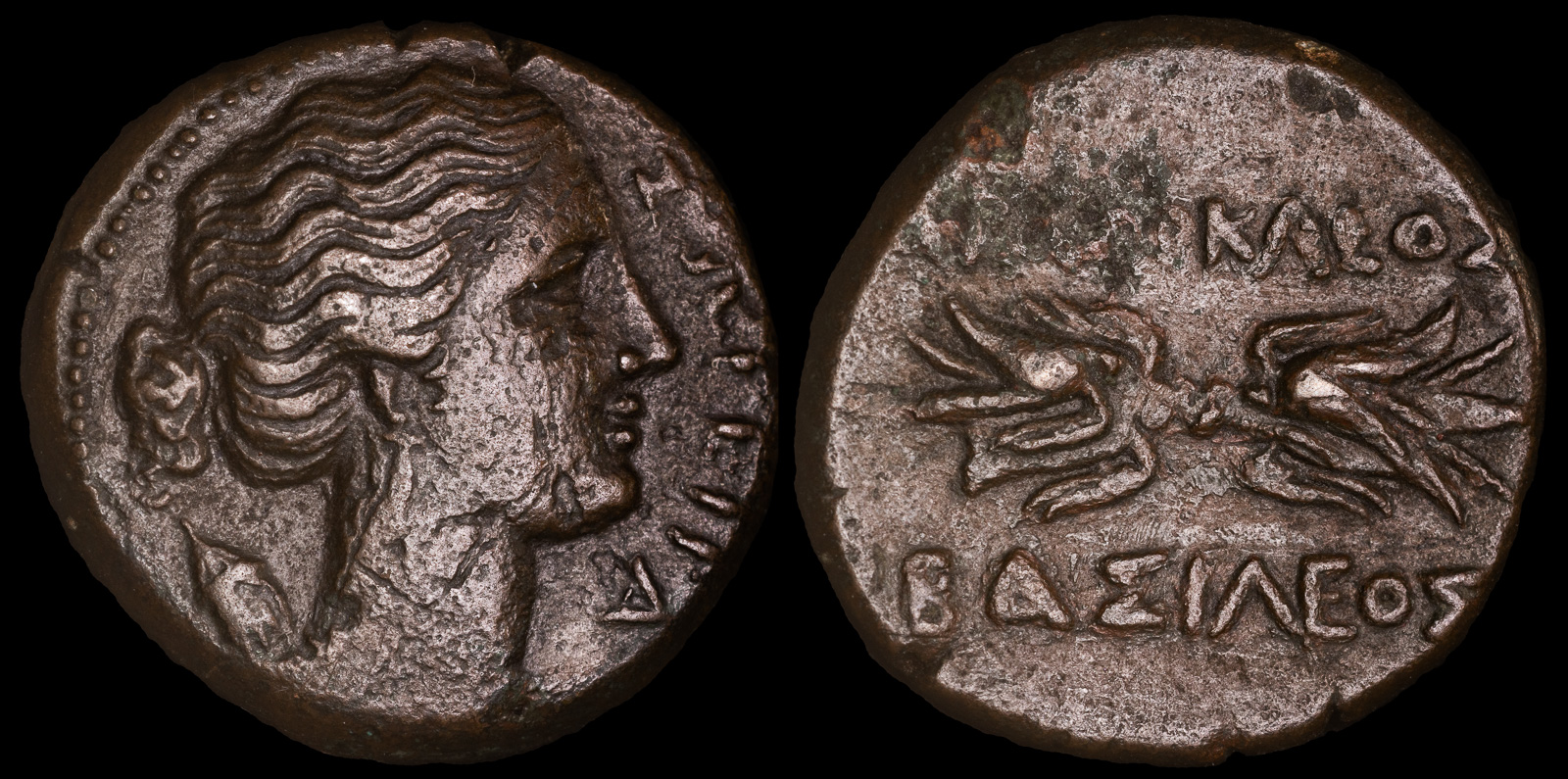
Sicily, Syracuse. Agathokles
Period 4, circa 295 BCE
Æ Litra 23mm, 8.35 gm, 1h
ΣΩTEIΡA, head of Artemis Soteria right, wearing triple-pendant earring and necklace, quiver over shoulder / AΓAΘOKΛEOΣ BAΣIΛEOS, winged thunderbolt.
Calciati II pg. 279, 142/25; SNG ANS 708; Favorito 34
Syracuse has such a long and amazing history that I’ll do it no justice here. Indeed, for a large portion of antiquity it was the strongest Greek state in existence – more powerful than even Sparta and Athens. The only came to a strong headwind once, when Athens went on its disastrous invasion of Syracuse during the Peloponnesian War.
Otherwise, Syracuse resorted to tormenting its neighbors and cycling through a seemingly never-ending parade of tyrants.

Agathokles 317 -289 BCE
Syracuse Sicily
Ae Trias 22.1mm, 8.4gms
Obv: SOTEIPA; Draped bust of Artemis Soteira right with quiver over shoulder
Rev: AG AThOKLEOS BASILIEWS; Winged thunderbolt
SNG ANS 708
Over time, I hope to expand this page. I must admit I’m not as familiar with the history of Syracuse since my focus has been on more around Greece and Turkey.
Syracuse is founded by settlers from Corinth.
Settlers from Syracuse found Akrai.
Settlers from Syracuse found Kasmenai.
Settlers from Syracuse found Kamarina.
Settlers from Syracuse found Morgantina.
Gelon of Gela takes Syracuse.
Theron makes himself tyrant of Akragas and forms an alliance with Gelon of Gela and Syracuse.
Death of Gelon, tyrant of Syracuse. His brother Hieron takes over.
Thrasydaios succeeds Theron as tyrant of Akragas. Hiero I of Syracuse invades and overthrows him.
Death of Hieron, tyrant of Syracuse.
Thrasyboulos sets up a democracy in Syracuse.
Ducetius, leader of the Sicels, defeated at Nomae by Syracuse, but is allowed into exile.
The Spartan general Gylippos takes Iaitas on his way from Himera to Syracuse.
Metapontion provides a small support force to Athens against Syracuse.
The Athenian forces in Sicily are destroyed by Syracuse.
Pharnabazos orders ships built at Antandros. At the same time, Syracuse helps Antandros finish its city wall, resulting in citizen privileges for Syracusans there. When the ships are complete, Pharnabazos sails for Kalchedon.
Dionysios I of Syracuse takes control of Enna through treachery.
Syracuse signs a treaty with Carthage that increases its possessions.
Hipponion taken by Dionysios I of Syracuse.
Plato travels to Syracuse on the invitation of Dionysios I.
Eudoxos assumes the head of the Academy at Athens while Plato is in Syracuse.
Plato returns to Syracuse to work with Dion.
Plato arrives in Syracuse for the third time.
Dionysios the Younger, tyrant of Syracuse, is expelled by Dion.
Dionysios the Younger reclaims the throne of Syracuse.
Hiketas besieges Dionysios the Younger in Syracuse.
Agathokles moves with his father, a potter, to Syracuse.
Agathokles begins his military career serving in the army of Syracuse under the leadership of Timoleon.
Timoleon of Syracuse drives Carthaginians out of Akragas and declares it a free city.
Agathokles marries the daughter of a wealthy Syracusan citizen, which helps him rise in social and political standing.
After years of service in the army, Agathokles gains popularity and starts to accumulate power in Syracuse, becoming involved in political conflicts.
Agathokles seizes power in Syracuse by staging a coup. He establishes himself as a tyrant, eliminating his political rivals and ending the democratic government.
Agathokles of Syracuse begins a campaign to expand his territory in Sicily. He conquers several neighboring cities, including Gela and Messana.
Agathokles of Syracuse temporarily takes Kentoripai.
Outbreak of the Agathokles War: The tyrant Agathokles of Syracuse invades North Africa, threatening Carthage but is ultimately repelled.
Agathokles‘ conflict with Carthage escalates. Agathokles faces a major invasion by the Carthaginian general Hamilcar, who besieges Syracuse. In a daring move, Agathokles decides to strike back by invading North Africa.
Kephaloidion attacked and taken by Agathokles of Syracuse.
Kentoripai taken by Agathokles of Syracuse.
Korkyra is again besieged by Kassander, but Agathokles of Syracuse destroys his fleet.
Agathokles dies of natural causes at the age of 72. On his deathbed, he decides not to pass his power to his descendants, attempting to restore a democratic government in Syracuse.
Hiero II seizes power in Syracuse.
Hieronymos becomes king of Syracuse.
Syracuse is besieged by Rome.
Syracuse is finally taken by Rome. Archimedes is killed.
Sicily is reorganized as a Roman province, including Akragas, with its administrative center at Syracuse.
Cicero serves as questor of Sicily at Syracuse.
The inhabitants of Akragas and Syracuse receive full Roman citizenship after the death of Julius Caesar.